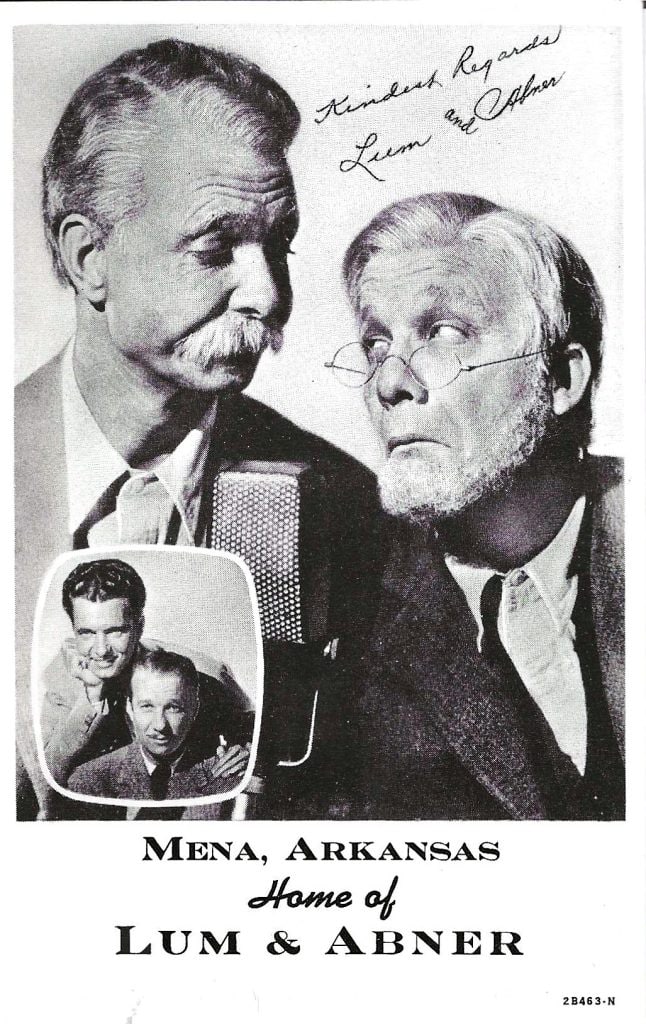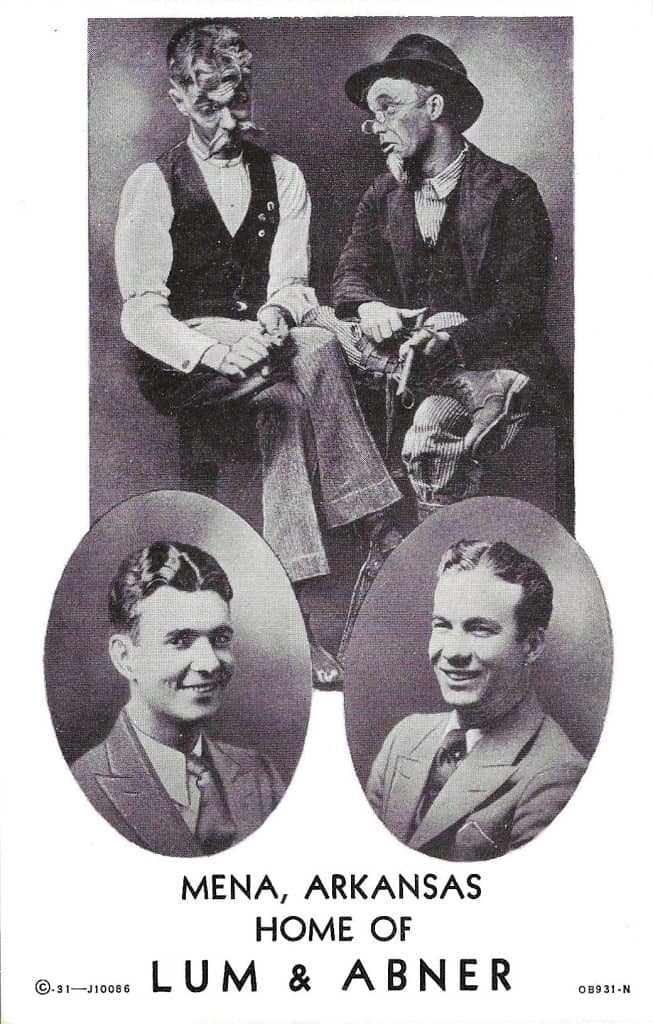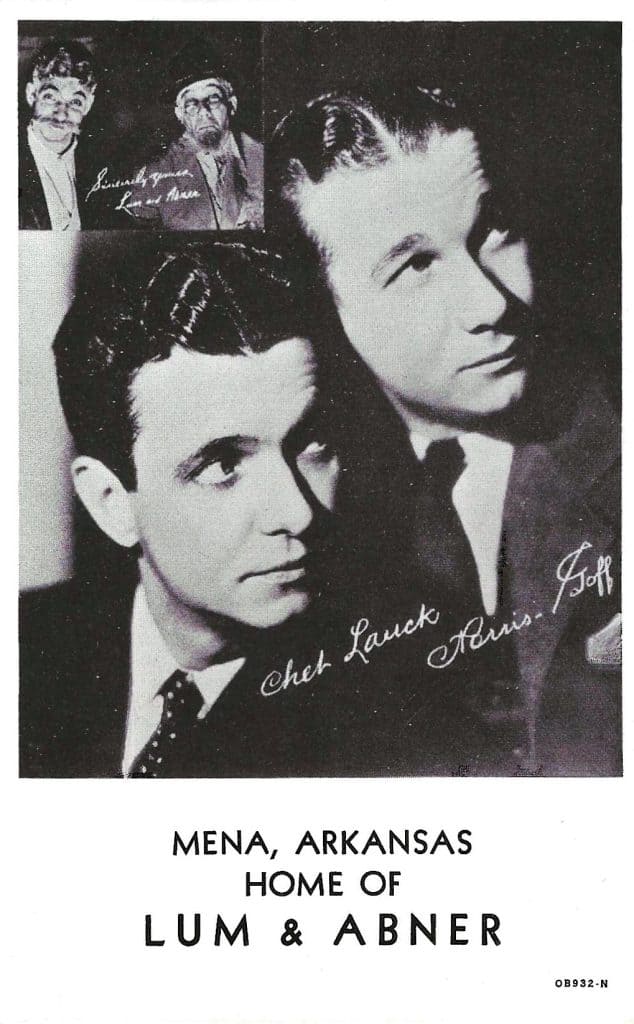In 1930 and again in 1932, the Curt Teich Company published “N” series postcards on behalf of a small photo studio in Mena, Arkansas. Mena was founded as a residential center around the same time as the Kansas Southern Railroad was built. The town has had regular train service since 1896. Today, the six-thousand residents are proud that their town serves Polk County as the county seat.
Through the years two of the notable people who have called Mena, “home” are Dorothy Shaver (the first woman to be president of a multi-million dollar business) and Herbert A. Littleton (a U.S. Marine (Pfc) who won a Medal of Honor posthumously for his bravery during the Korean War). Among the others, who were professional sportsmen and businessmen are two men whose names are far less known today than they were 70 to 80 years ago: Norris “Tuffy” Goff (1906-1978) and Chester Lauck (1902–1980).
Goff and Lauck met at the University of Arkansas and remained friends the rest of their lives. Goff was a radio actor, who played Abner Peabody in the famed Lum and Abner radio comedy and later television program; and Chester “Chet” Lauck, was the other half of the Lum and Abner comedy pair. Lauck played Columbus “Lum” Edwards.
From 1931 to 1954, Lum and Abner aired five days each week at 8:15. Four days of the week it was sponsored by Quaker Oats, the other day’s sponsor was One-A-Day vitamin pills. Ford Motor Company also figured into the mix on many occasions. The show followed the adventures of two friends, Lum Edwards and Abner Peabody, in the fictional town of Pine Ridge, Arkansas.
Lum and Abner were store proprietors who often found themselves in humorous and often absurd situations. Lum was the more intelligent and ambitious of the two, while Abner was more naïve and easily led astray. Their dynamic and comedic banter created an instant loyal audience.
Part of the draw to the show was the ensemble cast of weird, but memorable characters. There was Lizabeth Candy, the town gossip, and Cedric Weehunt, the bumbling but lovable policeman. These and other cast members, like Llewelyn “Mousey” Grey and Grandpappy Spears, made Pine Ridge a colorful small American town in which the title characters’ misadventures could be told.
Lum and Abner were not strangers to early 20th century idiosyncrasies and quirky behaviors of rural Americans, especially when it came to gossip and the annual corn husking contest. The daily scripts were created by writers using BULLETIN font typewriters, who clearly understood the close knit community where everyone knew each other’s business.
One of the hallmarks of Lum and Abner was its ability to blend humor with heart. In Hunting the Lion, one of the early episodes that aired on January 2, 1933, an elephant has pulled the door off the jailhouse, which in turn, allowed the resident lion to escape. The lion is old and toothless, nevertheless, the community is terrified. [The reason for a lion living in the jail is never disclosed.] To help their fellow townsfolk, Lum and Abner are lion hunting from their “lion hunting headquarters” in Abner’s garage.
After a couple attempts, the lion hunt has yet to be successful, so Lum is questioning Abner about his reasoning that the elephant (whose name is “Baby”) should be used to hunt down the lion. Lum reminds Abner that elephants can’t bark, so they should use dogs instead. Through it all Abner is concerned about how poorly the elephant’s skin fits.
Lion Hunt is an example of how, despite the comedy, the show tackled serious issues such as friendship, loyalty, and community.
The show’s popularity was not limited to radio, they set off for Hollywood in the 1940s and produced a series of successful films. It was the films that brought about the controversies. There always are some!
The show came under fire for its portrayal of African American characters, particularly the use of blackface. While the show did feature African American actors in some episodes, they were often relegated to minor roles.
Considering the times, Lum and Abner remains a classic of early radio programming because of the enduring central characters. Remember the time when Abner bought ten cases of the world’s Wonder Soap from a salesman from the New Discovery Chemical Company? Abner tells the salesman, Mr. Hedges, who Abner calls Mr. Hedge, that there isn’t a single thing he needs in his store and later learned that he just bought 25-cent soap for 50-cents, and still thinks he can sell it all to the good people of Pine Ridge in one day.
For those who enjoy the Lum and Abner style of humor, they were likeable characters. They were down-to-earth storytellers who made the world laugh in a naïve and simple fashion. And, they may continue to shine lights on the funny for years in the future. Their postcards will help with that!




Marshall Jones, later known as “Grandpa” during his days as a regular on the TV show “Hee Haw”, was a member of the Lum and Abner house string band.
Yes! He was in the 1932-33 “Friday Night Sociable” programs which aired on Friday evenings.
I love Lum & Abner They can still be heard occasionally on Siruis/XM radio station 148. One of my favorites of old time radio!
This reminded me, at least a little bit, of Car Talk’s Click and Clack, the Tappet Brothers, Tom and Ray Magliozzi, but sadly I’ve never seen any Car Talk postcards.
Dr. Cleveland, I mean no disrespect, but there are numerous errors in the history of Lum and Abner in this article. As a founding “ossifer” of the National Lum and Abner Society, I joined the other “ossifers” in a great deal of research on the careers of Lauck and Goff. For 23 years, we published The Jot ‘Em Down Journal which collected and published our findings in 133 issues. They are all available, free of charge, in PDF and MP3. I’d be happy to share a link here, with your permission. Also I’d be glad to answer any questions. Thanks!